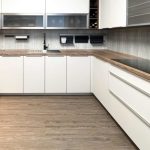Parquet floors are made by arranging wooden blocks in different geometrical patterns, typically on a sub-floor using suitable glue. In the old times, these were composed of small strips of wood and fixed using bitumen, but these days, different dimensions of parquet flooring are available and glued with high-quality adhesives. As the Parquet floors are woody, this makes them easy prey to damage and destruction. Proper maintenance and repairing can prove to be long-lasting and retain their appearance. Damage to these floors can be because of regular scratches caused by heels, furniture movement, pet nails, etc. Sometimes underground wire or pipeline installation requires a piece to be removed and refixed. Moisture and a fireplace in the vicinity have an equal effect of damage on these floors.
Further, natural expansion and contraction cause the pieces to fall apart. Sometimes underground water level results in the chipping of individual pieces or the module of parquet. Improper installation and gluing may be the reason for early damage to the Parquet floor. Parquet Floor repairs can be easily done depending on the type of material and problem. Here are listed some of the repairs related to parquet flooring:
- Regular scratches: Use furniture polish or repair oil to remove the scratch using a soft lint cloth until the scratch disappears.
- Dents: Moistening can help reduce the dent. Moisture swells the dent, filling it. For stubborn dents, place hot iron after placing a damp cloth over the dent.
- Edging: Use a hammer to strike a little settling the parquet piece into its position. It may create small scratches not noticeable easily.
- Wood putty: For holes, clean and dry the surface thoroughly and then apply wood putty after mixing to the hole with a plastic spatula.
- Removed planks: For planks that are completely removed, use suitable adhesive to fix them again. If originally bitumen was used for flooring, it may have made the underneath floor uneven and thus need to be cleaned and chiselled to make the surface smooth. Also, sometimes, the bottom part of the removed parquet will need to be eliminated for proper installation, back in its place.
Parquet flooring originated in France and has been in use till today with its traditional and contemporary designs. French Parquet Flooring was in vogue during the 16th century when parquet was fixed with concrete but gained popularity during the 1670s after Louis XIV ordered the replacement of marble flooring with parquet due to leaking joists. These came to be known as Parquet de Versailles and have developed into today’s delicate designs. The most popular designs are herringbone and Chevron. Chevron Parquet flooring involves placing the parquet pieces at a certain angle and can be identified by considering the floor as a motorway with V-shaped patterns. Herringbone patterns are made by placing parquet at 90-degrees to each other and are most common with households, although they make the room look tinier.










